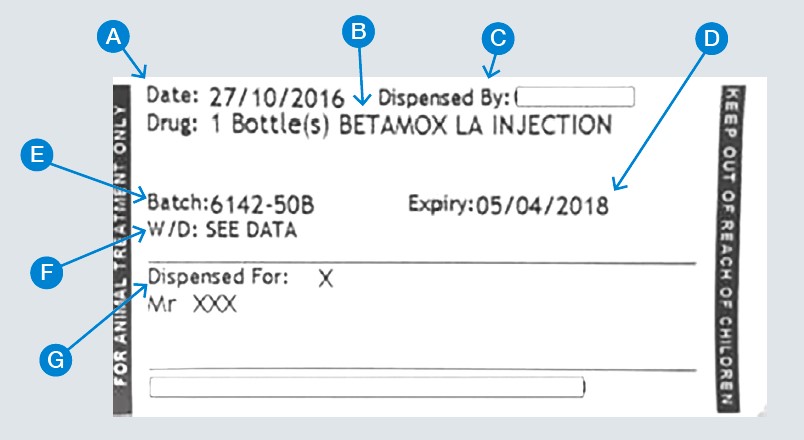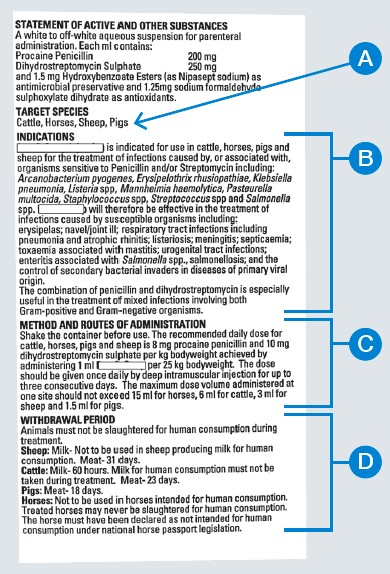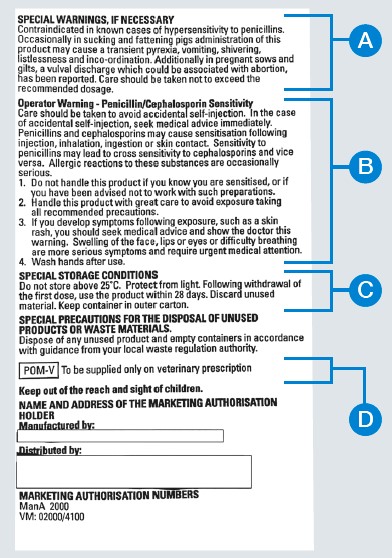- Home
- Knowledge library
- Livestock medicine: Labelling and storage
Livestock medicine: Labelling and storage
Storage, shelf life and disposal of medicines are all important aspects of responsible medicine use. Find out more about medicine labels and why they are important.
Back to: Responsible use of medicines in livestock
What does the medicine label show?
All medicines prescribed by the vet will have a label attached to them. The label instructions are the official recommendations on how to use a medicine and are the most cost-effective way to administer a drug.
Ignoring or altering dosages, administration routes or storage recommendations may result in the drug being ineffective and can be detrimental to animal health.
Medicine label

A. This is the date the bottle was dispensed for your purchasing/medicine records.
B. Name and amount of the drug being dispensed. This will also be on the main label on the bottle.
C. This is the person who dispensed the drug so it can be traced back if there are any problems.
D. This is the expiry date of the drug. Once past this date, the drug may not work properly, if at all.
E. Batch number of the drug for the farm records.
F. Withdrawal information. If not specifically printed here, the information will be clearly visible on the back of the bottle or box.
G. Farmer’s name, farm name and address will be printed here. There will also be details of dosage and administration. If the label states ‘use as directed’, the dosage and administration information will be clearly visible on the back of the bottle or box.
Information found on the medicine box or bottle

A. These are the species for which the medicine has been licensed.
B. These are the infections that the medicine can be used to treat. Veterinary advice should always be sought to ensure an accurate diagnosis has been reached.
C. This is where information on dosage rates and how to administer the medicine can be found. This information should be followed carefully.
D. Medicine usage should be written down to keep track of withdrawal periods. It is an offence to send animals to slaughter while still in the withdrawal period of a medicine.

A. This section includes any adverse reactions to the medicine that have been reported. Any adverse reactions should be reported to the vet.
B. These are warnings for the person administering the medicine. Read carefully, as some medicines are dangerous to pregnant women.
C. These are instructions on how the medicine should be stored. These are different for every medicine, so always check the box or bottle.
D. This is the class of the drug, which indicates who is allowed to prescribe and sell it.
Medicine storage
Every medicine has its own specific storage instructions, which can be found on the label or in the packaging insert. These should be followed closely because many medicines are sensitive to light and temperature. The active ingredient in the medicine will be compromised if it is not stored correctly, causing it to be less effective, if not completely ineffective.
Make sure medicines are stored in an appropriate locked store – either a medicine cabinet or fridge, rather than leaving them in farm vehicles, sheds or near livestock pens or handling equipment.
Fridge storage
The fridge temperature should be maintained between 2°C and 8°C. This should be checked regularly using a thermometer as a recent survey found that many farm fridges were either too warm or too cold.
For fragile medicines, such as live vaccines, being stored at the incorrect temperature can destroy the vaccine and render it totally ineffective. Using min/max thermometers to monitor the temperature of medicine storage areas will help ensure you know if a product has been exposed to temperatures that render them ineffective.
Location
The middle of a fridge generally has the most constant temperature, so this is the best place to store medicines that require refrigeration. Keep bottles in their boxes as this helps protect medicines from light.
Transportation
Take care when transporting medicines. If the medicine is supposed to be kept refrigerated, it should not be allowed to warm up at any time. Use a cold box or bag to transport medicines and avoid leaving them in a vehicle for any length of time.
Medicines shelf life
Every medicine has a specific shelf life after the bottle or container has been opened for the first time. This will be stated on the product label and on the data sheet. It is important to check this and to record both the date of first opening and the date after which the medicine should not be used. Continuing to use medicines after this time may be ineffective or harmful to the animals treated.
When drawing multiple doses out of the same bottle of injectable medicine:
- Either use a multi-dose syringe or leave a clean needle in the bottle to reduce the number of times the bottle is pierced
- Always change to a new needle when drawing from a different bottle of medication as using the old needle may introduce contamination
- Never re-enter a bottle of injectable medicine with a needle that has already been used for an animal injection because this will risk contamination
- Remove all needles from bottles before storing
Medicine disposal
All out-of-date or unwanted animal medicines, containers, syringes and needles must be disposed of safely.
Always follow any specific advice on the label with regard to disposal. Do not hoard partly used medicines in case they may be useful later and never pass them on to anyone else; it is illegal to do so.
Speak to the vet regarding disposal as they should be able to provide a DOOP (disposal of old pharmaceuticals) bin, which you can use for old bottles and used syringes.
Most vets offer a service whereby the filled bin is returned to the vet practice for collection and disposal by a registered waste disposal contractor. Sharps must be disposed of in a purpose-made container and removed through an approved route. They should never be put in domestic waste. Most vets will also provide a sharps container for used needles.
A record should be made of any medicines that have been disposed of and not used to treat animals.
If a medicine changes colour or becomes thick or lumpy, check with the vet that it is still safe to use. The medicine will probably be wasted and must be discarded appropriately and a new bottle used. It is important to inform the vet if there are any adverse reactions in treated animals.
Useful links
If you would like to order a hard copy of Using medicines responsibly, please contact publications@ahdb.org.uk or call 0247 799 0069.
Topics:
Sectors:
Tags:

